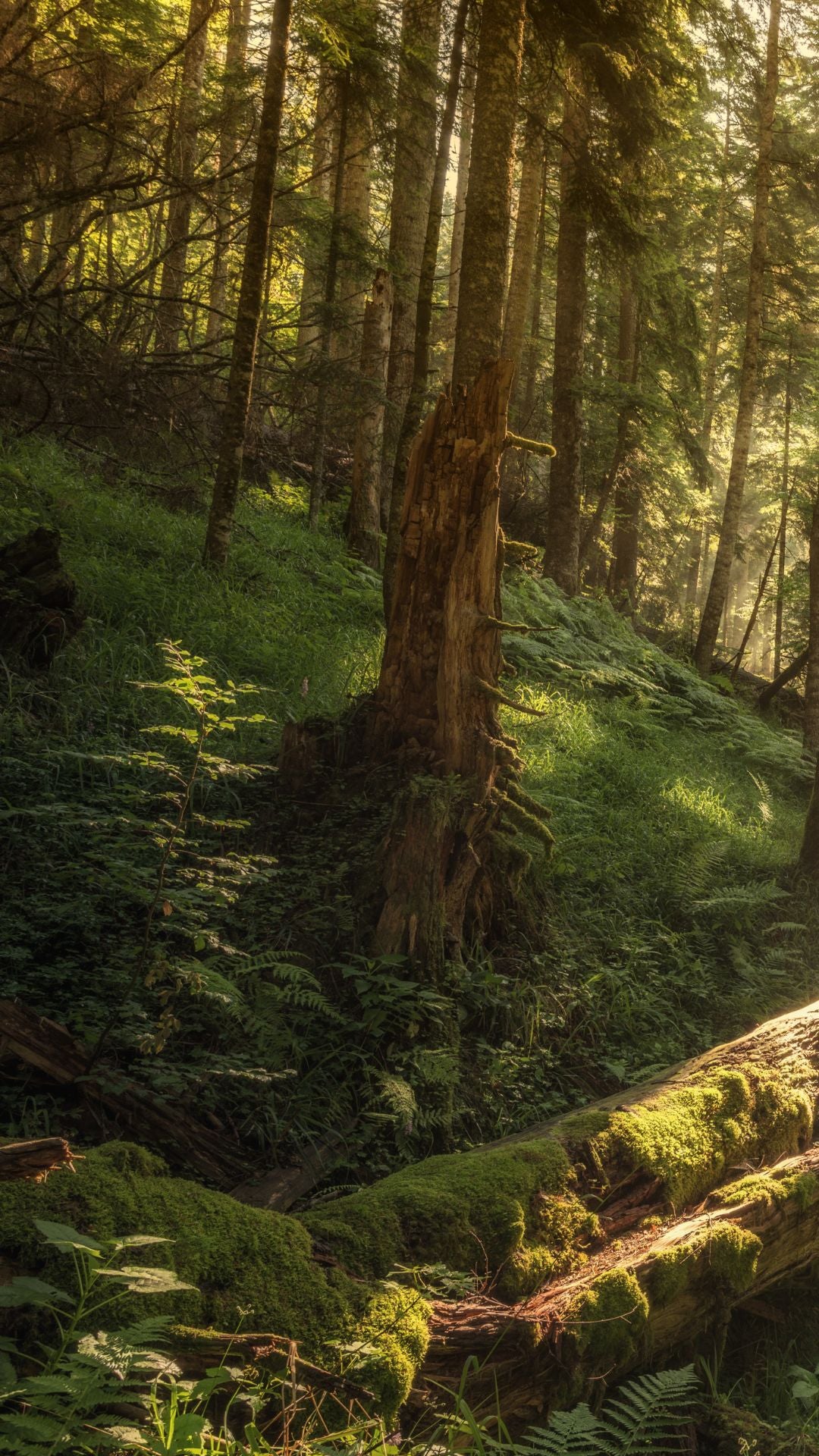Trees are sacred because they helped create this world, because they live on sunlight and soil and give us oxygen to breathe. They are sacred because they regulate the weather, the rain and the water of the earth, and have given of themselves for countless millennia, ages and epochs so that other beings can have food and shelter, warmth and shade.
The earth was once covered in vast and ancient forests, and humans lived surrounded by elders that towered over them and outlived them by many generations. It is not surprising that worship of trees is one of the oldest forms of spiritual devotion, something we might want to reconsider, as the web of biological interdependence originating from trees continues to unravel.
Let’s take a few minutes to remember the sacredness of some specific trees, which can be enhanced by using a few drops of essential oil from some of the aromatic species.
How can we remember the sacredness of conifer trees?
There is a unique fragrance that is typical of traditional medical clinics in the Himalayas, such as the one in Kathmandu where I studied and worked with my teacher of Tibetan medicine, Dr. Ngawang Choephel. It is the aroma that wafts from the mortars as doctors and assistants grind the dry herbs to make medicine pills, of jatamansi roots, rhododendron flowers, nutmeg and cardamom, species common and rare, and the leaflets of the conifers such as cypress, juniper, and cedar.
The conifer leaflets are used especially in recipes for medicinal incense. The formulas are old, calligraphed on faded handmade paper and bound in wooden casings, describing their powers when compounded from auspicious and propitious materials and made in accordance to the processes prescribed by the mystics and healers who created or discovered them. The texts have simple descriptions of their uses: “For religious offerings and meditation practice. To promote an overall sense of calm and mental and physical well-being. For prayer and to ward off negative influences. This incense brings spontaneous blessings from the enlightened beings.”
Aromatic memories are especially vivid when fragrances are part of spiritual practices.
These classical incenses of Tibet, Bhutan and Nepal that are based on Himalayan conifers, are for many people the olfactory memories that take them back to meditation retreats where they were used. My memories are of the dry conifer leaves being placed on coals in the incense burner, typically at the same time the drums and bells and chanting became the loudest. In one retreat, the memories of those trees as offerings and purification smoke are particularly clear, because the sense of smell is heightened when we are fasting, and this was a fasting practice of 21 days.
Put a drop of a conifer oil on your fingertips, such as the cypress from Bhutan, and inhale it slowly. Remember that this is the aroma of the forests, rich in healing compounds, rich in collective memories of prayers and meditation, rich in mantras and visualizations of celestial realms and deities, rich in powers of purification and cleansing. This is how we can remember the sacredness of all conifer trees everywhere, because they have been used universally for the same spiritual purposes in all cultures, and are therefore an intrinsic part of our shared humanity.
How can we remember the sacredness of Palo Santo?
In the past, when people left their village and set off on the trail, either into the forest or to another village or town, they would stop at the first Palo Santo tree. They would touch it reverently, and ask it to give protection along their journey. Later, when they returned, they would again greet the tree and offer thanks for a safe return.
Most of us do not live around Palo Santo trees, and those that do are losing interest in these practices, but we can keep them alive and remember this ancient relationship, simply by inhaling some of the tree’s oil before we start our journey through the day, asking for its protection, and thanking it again when the day is over. As we do this, we can think of the tree as a protectoress, because those that give the most oil are females.
In the humid tropical dry forest of Machalilla Park on the coast of Ecuador stands an old Palo Santo tree. It is a female, and is regarded as the mother tree of the forest. She is majestic and rare because she is so aged, maybe 130 years; her branches arch over the trail, giving welcome relief from the stifling heat. Her trunk is scarred with a history of the past. When a couple was expecting a child, the father would make a pilgrimage through the forest to this tree; he would come with a machete, and scar the trunk to gather resin for medicine. The resin was put on the umbilicus of the newborn, as a ritual of benediction, with medical benefits. Fathers no longer come here for this purpose, just as they no longer ask the trees for protection, but we can keep these memories alive by including smudging ceremonies with Palo Santo wood during important life transitions, both joyful and sad, in our own life and in the lives of others.
Palo Santo trees are especially powerful for healing sadness. If you ever have the good fortune to sit in a traditional Palo Santo ceremony in Santa Domingo de los Tsachilas in Ecuador, with a shaman whose hair is painted red and his clothes made out of feathers, you will find yourself in a small room with the windows and doors sealed. The room will fill with the acrid sweet limonene smoke of the wood; your eyes will begin watering, your lungs will begin to burn.
On your behalf, the shaman will call out to Pachamama, to brother sun, to sister moon and to mother water. More smoke will come, breathing will get harder, time will slow, the outer world will fade. Suddenly, it will be over; the shaman will open the doors and windows, fresh air will come pouring in and with it the light of Spirit. Breathing slowly and deeply, you will find that the existential sadness that burdened your heart for so long has vanished, replaced by an indescribable psychoactive experience of neurochemical euphoria.
Palo Santo is a powerful medicine for healing sadness, and stopping panic attacks, and removing negative mental states, and when it has done those things and the sadness has lifted from the soul and the heart is no longer agitated with fear, we are closer to the sacred, and it is more present in us. We can remember simply by inhaling the oil that this tree is sacred because it touched our spirit.
What is sacred about Rosewood, and how and why should we remember it?
The most obvious answer is that only a few of the old trees remain, hidden in the deepest forests of the Amazon, where their rarity makes harvesting them both illegal and incredibly lucrative to poachers. Every time one falls, another part of the human psyche dies, never to be replaced, because no one in the foreseeable future will meet these elders, or know the world they grew in that no longer exists. In that sense, the aroma of Rosewood is sacred because it is a link with a vanishing planet, and all its wonders and abundance that made us human. Rosewood oil is a drop distilled from the original garden, an ancestral perfume that can elicit an olfactory memory of the last echoes of primeval wilderness, and its magic and powers.
Rosewood is the aroma of goodness in the human heart, the love of the forests, and the desire to protect the land and water and animals and what remains of the old cultures they nourished, that now motivates a small number of dedicated individuals to establish plantations of Rosewood saplings, that are slowly coming of age to give their oil not through the heartwood of massive trunks and ancient roots but fragrant tender leaves. Rosewood oil is sacred, therefore, because it is the essence of hope, and new beginnings, and the tender growth of a fragile global garden being reborn.
Put a drop on the fingertips and inhale it slowly, remembering all these things. Remember that the trees once grew to massive dimensions; remember that their beautiful rose-colored heartwood and sweet oil were treasures that were so valuable that they brought the trees to near extinction. Remember that those old trees lived for centuries, generation after generation, descending from the realms of myth where the lives of early humans moved between worlds in visions and dreams, when people and trees understood each other’s languages.
Remember that people with love, hope and courage in their hearts sweated in the tropical heat surrounded by the ever-present mosquitoes, to plant the trees and harvest their leaves and distill them in simple stills, so you can now inhale their sweet floral scent.
Stay tuned for Part II of this incredible series about sacred trees!




















